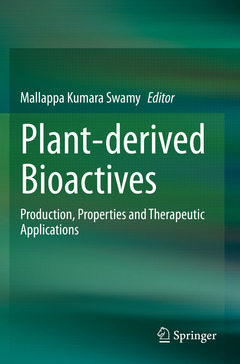Description
Plant-derived Bioactives, 1st ed. 2020
Production, Properties and Therapeutic Applications
Coordinator: Swamy Mallappa Kumara
Language: English
Subjects for Plant-derived Bioactives:
Publication date: 05-2021
619 p. · 15.5x23.5 cm · Paperback
Publication date: 05-2020
Support: Print on demand
Description
/li>Contents
/li>Biography
/li>Comment
/li>
Plants produce a vast number of bioactive compounds with different chemical scaffolds, which modulate a diverse range of molecular targets and are used as drugs for treating numerous diseases. Most present-day medicines are derived either from plant compounds or their derivatives, and plant compounds continue to offer limitless reserves for the discovery of new medicines. While different classes of plant compounds, like phenolics, flavonoids, saponins and alkaloids, and their potential pharmacological applications are currently being explored, their curative mechanisms are yet to be understood in detail.
This book is divided into 2 volumes and offers detailed information on plant-derived bioactive compounds, including recent research findings. Volume 1, Plant-derived Bioactives: Chemistry and Mode of Action, discusses the chemistry of highly valued plant bioactive compounds and their mode of actions at the molecular level. Volume 2, Plant-derived Bioactives: Production, Properties and Therapeutic Applications, explores the sources, biosynthesis, production, biological properties and therapeutic applications of plant bioactives.Given their scope, these books are valuable resources for members of the scientific community wishing to further explore various medicinal plants and the therapeutic applications of their bioactive compounds. They appeal to scholars, teachers and scientists involved in plant product research, and facilitate the development of innovative new drugs.
1) Effect of conventional and non-conventional processing on plant-derived bioactive compounds.- 2) Molecular way – adequacy in phytomedicine screening.- 3) Production of plant bioactives through biotechnological approaches.- 4) In vitro culture approaches to produce camptothecin: Recent advancements and challenges.- 5) Endophytic microbes as a source of plant-derived bioactives.- 6) Essential oils: An update on their biosynthesis and genetic strategies to overcome production challenges.- 7) Plants and some phytochemicals in the prevention of cataractogenesis: promising results from preclinical observations.- 8) Tropical fruits as a source of therapeutically potential agents.- 9) Pomegranate peel and its anticancer activity: A mechanism based review.- 10) Essential oils as effective agents against neurological disorders.- 11) Dietary phytochemicals with pharmacological significance.- 12) Bioactive phytocompounds to fight against Antimicrobial Resistance (AMR).- 13) Phytochemicals inthe prevention and cure of cancer.- 14) A review on the effect of bioactive compounds present in Oroxylum indicum plant against cancer cells.- 15) Colon cancer prevention and treatment – a phytoderivative approach.- 16) Antimalarial agents from medicinal plants.- 17) Role of phytocompounds in cosmeceutical applications.- 18) Role of phytocompounds in cosmeceutical applications.- 19) Phytochemical and pharmacological appraisal of barks used in Unani system of medicine.- 20) Bioactive polyphenols for cardiovascular disease management.- 21) Naturally occurring Coloring and Flavoring agent.- 22) Phytochemicals as Anti-Viral Agent.- 23) Traditional plant compounds for the treatment of neuropsychiatric disorders.- 24) Health Benefits of Bioactive Compounds from Vegetables.- 25) Neuroprotective compounds from plant sources and their mode of action: An update.- 26) Indian tropical fruits and their bio-active compounds against human diseases.- 27) Nanoscale systems for the improvedtherapeutic applications of phytoconstituents.- 28) Phytonanotechnology: Enhancing the delivery of Phyto constitutents.- 29) Bioactive xanthones from Garcinia mangostana.- 30) Computational Approach to Analyze Phytocompounds Interactions in Drug Development.- 31) The role of phytochemicals in cancer prevention and cure : A review.
Dr. Mallappa Kumara Swamy is a Professor at the Department of Biotechnology at East West First Grade College (Affiliated to Bangalore University), Bengaluru, India. He pursued his postdoctoral research at the Department of Crop Science, Faculty of Agriculture, Universiti Putra Malaysia (UPM), Serdang, Malaysia from 2014 to 2018. Before that, he worked as an Associate Professor and Head of the Department of Biotechnology at Padmashree Institute of Management and Sciences, Bangalore University, Bengaluru, India. He obtained his PhD (Biotechnology) from Acharya Nagarjuna University, Guntur, India, in 2013. He has more than 16 years of teaching and research experience in the fields of plant biotechnology, secondary metabolites production, phytochemistry and bioactive studies, and he has published more than 100 research papers in peer-reviewed journals and 25 book chapters. He has edited 10 books with Springer Nature Singapore Pte Ltd., CRC Press (Taylor & Francis Group), USA, andStudium Press, India. He is also an editorial board member and reviewer for various high-impact international journals. He currently works in the area of natural product research, plant cell and tissue culture technology for bioactive compounds production and evaluation of their bioactivities. His research also focuses on nanobiotechnology for medical applications.




